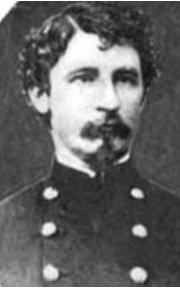Dunbar R. Ransom facts for kids
Quick facts for kids
Dunbar R. Ransom
|
|
|---|---|
 |
|
| Born | January 10, 1831 Fayetteville, North Carolina, U.S. |
| Died | July 11, 1897 (aged 66) Fort Worth, Texas, U.S. |
| Allegiance | |
| Service/ |
|
| Rank | Colonel |
| Battles/wars | American Civil War |
| Alma mater | United States Military Academy Norwich University |
Dunbar R. Ransom (born January 10, 1831 – died July 11, 1897) was an important officer in the United States Army. He fought in the American Civil War. He was known for leading Union Army artillery groups during the war.
Contents
Early Life and Military Start
Dunbar Ransom was born in Fayetteville, North Carolina on January 10, 1831. He grew up in Vermont. His father, Truman B. Ransom, was a Colonel. His brother, Thomas E. G. Ransom, became a General.
Dunbar Ransom studied at the United States Military Academy at West Point. He also graduated from Norwich University in 1851. On June 7, 1855, he became a second lieutenant in the 3rd U.S. Artillery. He served on the West Coast of the United States. He was promoted to first lieutenant on December 31, 1856. Ransom also took part in the Yakima War in 1858. He was part of an expedition that led to the Battle of Four Lakes in Washington.
Service in the Civil War
When the Civil War began, Ransom was promoted to captain on November 1, 1861. He was put in charge of Battery L of the 3rd Artillery. Soon after, he took command of Battery C, 5th U.S. Light Artillery. This unit fought alongside the Pennsylvania Reserves at the Second Battle of Bull Run.
Key Battles and Leadership
Ransom's battery stayed with the Reserves. They joined the I Corps of the Army of the Potomac. They arrived just in time for the Battle of Antietam. Major General George Meade praised Ransom's battery. He said they greatly helped the Reserves as they moved into the Cornfield.
Battery C also supported the Reserves at the Battle of Fredericksburg. Their attack broke through the Confederate lines for a short time. The next year, the battery served with the second division of I Corps. This was during the Battle of Chancellorsville.
After Chancellorsville, the Union artillery was reorganized. Artillery units were grouped into larger brigades. Ransom's battery joined the First Regular Brigade. Ransom then took command of this larger group. Lieutenant Gulian V. Weir took over command of Ransom's old battery.
Gettysburg and Beyond
At the Battle of Gettysburg, Ransom's brigade fought on July 2, 1863. Some batteries were on Cemetery Hill. Others were on Cemetery Ridge. On July 2, two batteries moved forward to support the III Corps. They were forced back by a Confederate attack. Ransom was wounded by a sharpshooter while leading a battery. He fell from his horse because of the wound.
After Gettysburg, Ransom's battery was sent to New York City. This was because of the New York Draft Riots in July 1863. After returning to the Army of the Potomac, Ransom joined the 2nd brigade of Horse Artillery. He served in the Bristoe Campaign and the Battle of Mine Run in late 1863.
In the spring of 1864, Ransom took command of the 2nd Horse Artillery Brigade. He led this group in the Overland Campaign. This included the Battle of the Wilderness and the Battle of Spotsylvania Court House. Later, Ransom again took command of his brigade before the Siege of Petersburg.
In late 1864, Ransom moved to the Union Army of the Shenandoah. He commanded combined artillery batteries there. His unit was involved in the Battle of Berryville. General Sheridan's writings show Ransom was present at the Battle of Cedar Creek. Ransom stayed in the Middle Military Division until the war ended.
During the war, Ransom received special promotions. He became a major on December 13, 1862. He was promoted to lieutenant colonel on July 3, 1863. Finally, he became a colonel on August 25, 1864. These were "brevet" promotions, meaning they were for bravery or special service.
After the War
After the war, Ransom stayed in the Army. He went back to his permanent rank of captain. In 1872, he faced some issues with his military status. He was dismissed from the service.
He then started working for the Fort Worth and Denver Railway. Later, the railroad president, Grenville M. Dodge, helped Ransom. Dodge brought Ransom's case to Congress. In 1892, a Congressional investigation looked into the matter. They found that Ransom had not done anything wrong. His Army pay had been delayed, which caused problems.
In 1894, Congress put Ransom back on the Army's official list. He was moved to the retired list, which meant he could receive a pension. Dunbar Ransom passed away in Fort Worth, Texas on July 11, 1897. He was buried in Fort Worth's Oakwood Cemetery.

